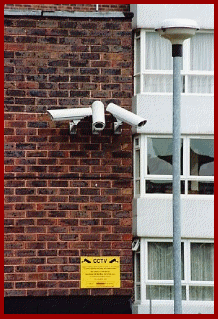|
Frequently Asked Questions (FAQ's)
Installation Q1) Our client wants us to install two cameras to watch the front of their premises; is it a good idea to fix them 'back to back' at the mid point of the building?
DJ says " Depending on the length of the frontage, it is preferable to arrange the cameras so that they effectively cross over each other; either one camera at each end of the building, or if it is a particularly long frontage, with the cameras each set in approximately one third of the distance from each end. Also be aware, that if they are less than 10 metres apart, here in the U.K. they will require planning consent from the Local Authority. Q2) We are intending to install a number of outdoor cameras to cover main parking and pedestrian access points. We've been asked to fit Infra Red lamps under each camera, but we don't know what type to install; can you help?
DJ says " First up, never place an Infra Red lamp directly under a camera; as the heat rises, you'll just gently cook it. If you must place a lamp (either IR or white light) try fitting it to one side of the camera, or if no other option, a metre above it. Most lighting tasks are dealt with more efficiently if the lamp is placed nearer to the area it is trying to illuminate.
The preferred option is always to try and use low level maintained 'white' light which of course is far more suitable from a Health and Safety perspective. If you must use Infra Red, try using the 830 - 850nM filtered lamps, low wattage or LED type for short range applications (>35 metres), and high output 500 or 600 Watt lamps for long range or wide area applications. Q3) The client has asked us to provide a mains supply for each indoor camera, using a 'fused' spur plate; where is the best position to install this?
DJ says " The fused spur arrangement, provides a flat plate with a (normally screw secured) cartridge fuse, which can be removed to isolate the camera (or power adaptor) from its mains electric supply.
Generally speaking, if the 'spur' can be fitted just out of view of the camera, it then becomes almost impossible to tamper with the supply, without the 'tamperers' hands showing up 'in camera'.
Be aware that recent changes in U.K. legislation, mean that you must be suitably qualified in order to take on this type of work. E-mail your comments, suggestions or questions to :- info[at]doktorjon.co.uk | | |
| IMPORTANT: No material may be reproduced, copied or redistributed from this site,
without the express written consent of doktorjon.co.uk
All the detailed information on this site is provided in good faith; and as such, Doktor Jon
does not accept responsibility for any consequential loss, injury or disadvantage
resulting from any individual or organisation acting on the details contained herein. © doktorjon.co.uk 2004 - 2008 Homepage...:...Gateway...:...Technical Gateway....:....Quickfind Index....:....Equipment Directory
Site Index...:...About this site....:....CCTV Helpdesk....:.... The Forum ....:....Contact Doktor Jon | | |




